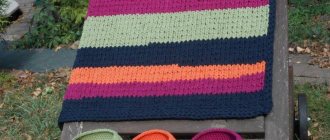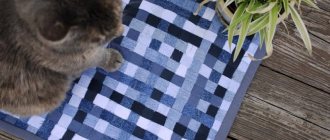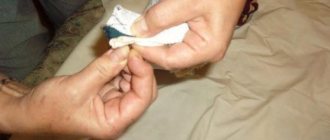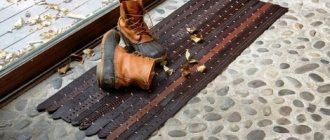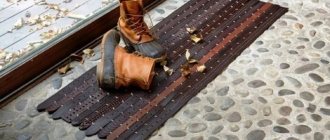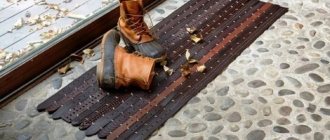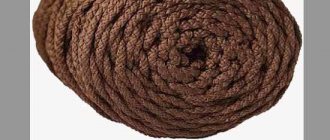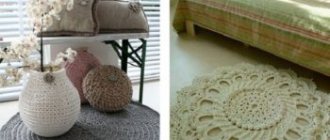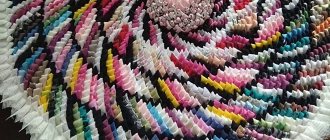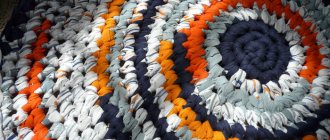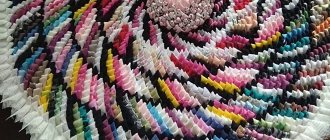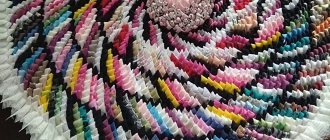In modern minimalist interiors, carpets are given less and less space; they are going out of fashion. But door and bedside rugs, rugs for the bathroom and children's room will always be relevant. Buying any of them is not a problem, but you can go the other way and make it yourself, finding a use for old things instead of thinking about where to put them.
DIY rug made from old things
This article will give you some interesting ideas for recycling all sorts of unnecessary or used things, of which there are many in every home. Don’t rush to throw them into the trash container; it’s better to make an original decoration and useful item for your home.
A bright rug - a second life for old things
DIY rugs made from braids
Do you know how to braid hair? The usual one, of three stripes? You can make amazing rugs with your own hands. What’s great about homemade braided rugs is that you can make them from just about anything. Any old things will do. Literally any. The best place to start is with knitted t-shirts. Soft, flexible material that is easy to work with. You can also use:
- Old towels, sheets or terry robes.
- Knitted items (sweaters, jumpers, but not very thick).
You can make amazing carpets from cords - Fleece blankets and sheets that have lost their appearance or relevance.
- Cords - ready-made or woven, tied.
- Old bathrobes, colored sheets.
- Jeans. You can make very interesting and beautiful rugs from old things. And not only for the dacha...
- Children's tights (and women's, by the way, too).
- Jute ropes.
And whatever you find and consider possible to use. When selecting materials, we try to find them of approximately the same thickness and density. Then there will be no problems with weaving. At first, you don’t have to think about choosing colors. When experience comes, it will be possible to select colors. It’s more pleasant to work with knitwear and terry cloth, but old jeans and jackets can also work.
Preparing tapes
We prepare the material for the braids - we cut the found “treasures” into strips. The width of the strip depends on how thick you want the rug to be. To begin with, you can make knitted strips 6 cm wide. Strips of terry cloth are also made of the same width. But in the case of knitwear, the rug will be 2-3 cm thick, terry - at least 5 cm.
If you use T-shirts, cut off the “body” exactly at the armpits. We use the resulting pipe in this form. We cut into strips, but not completely, but leaving 5-7 cm uncut at one seam (as in the photo on the left). You'll soon understand why.
How to make a long strip of T-shirt for a homemade rug
Turn the uncut part towards you (as in the middle photo), take scissors, and cut along the bias from the bottom to the first cut. The next gap is also cut on the bias. And so on. You complete the last whole piece like the first - reduce it to nothing to the edge. The result is a long strip, several meters long, with barely noticeable seams. And there is less work - no need to sew. It’s easier with towels - you just cut off the edge, then cut it into ribbons, but they will need to be sewn.
During operation, the tapes will have to be connected. They can be tied or stitched. But there is a convenient way that allows you to reliably connect two strips of fabric/knitwear without a needle.
How to join two strips when weaving a rug
We place the edges of the strips one on top of the other, by 3-5 cm. We cut a hole 1.5-2 cm long approximately in the middle (with a strip width of 5-7 cm). We pass the free strip through this hole. The result is a reliable knot, which, nevertheless, does not interfere with weaving, does not stand out and is not felt later in the product. To understand how it works, try it on small pieces.
Braiding hair
The braid is usually woven from three ribbons. The length of the stripes should not be the same. They will need to be tied or sewn (it is better to sew). And it is much better if the connection points are spaced some distance apart.
Preparing the “material” for a braided rug
We fasten the selected strips together. They can be wrapped in thread, sewn, knitted. The thickest knot is obtained. This is not always convenient. We braid a pigtail. When one of the strips ends, we sew or tie the second one.
Footage - as needed or desired. It also depends on the thickness of the braid. If it turns out to be voluminous, you won’t need much length. If it is thin, then you will need 5-8 meters. In any case, you can not finish the weaving, but fix it with something so that it does not unravel. You can grab it with a thread and a needle, tie it with a rope, or use a binder.
DIY rugs made from T-shirts: you can start assembling and not finish weaving
Assembling the rug
You can make a rug of any shape from a woven braid: round, oval, square, rectangular. To make a round homemade rug from T-shirts, twist the braid into a spiral on the table. Take a large needle and strong thread and sew it together. We make small stitches, connecting the woven braid centimeter by centimeter. This is perhaps the most time consuming part. But with this method of connection, a double-sided mat is obtained.
Weaving a rug from fabric strips - sewing braids
To prevent the end of the rug from looking unsightly, make the stripes increasingly tapering for the last meter or so. So that the braid becomes thinner and thinner. The length of this “tapering” section is equal to at least half the finishing diameter of the rug. It’s not a problem to fold a narrow edge down and sew it there. You can also hide the “tail” under one of the stripes in the braid. In general, this completion is aesthetically pleasing.
Oval rug made from T-shirts, scraps, old things
If you want to make an oval rug, you need to twist the braid around a straight section. The longer the section, the longer the resulting rug will be. If you want a square or rectangular one, you will have to braid the braid “in place.” To ensure that the turns are not smooth, but sharp, a special technique is used.
How to make a twist in a braided rug
At the turning point, leave the bottom strip free. The one that is currently on top wraps around the middle one. You need to make two or three turns, sometimes more. Having turned the work, we weave in a third strip, directing it over the one that was wound and passing it under the “main”. It's difficult to explain in words, look at the picture above.
Special models
Braids woven from old things can be the basis of very interesting carpets and rugs. For example, you can make a number of braids of the same length. Tie them tightly along the edges, leaving 5-10 cm free and cutting these parts into “noodles”. Sew the resulting pieces together. You will get a rectangular rug. It will be convenient near the front door, in the bathroom, etc. You can also make a rather long rug that can be laid near a sofa, armchair, or recreation group.
Variations of rugs made from old T-shirts woven into braids
From fabric or knitted braids you can make a rug from small fragments. An example of this is in the photo on the right (see figure above). You roll up fragments of certain sizes and assemble them. From the same set of “materials” you can get dozens of variations of “carpets” and rugs.
Options for carpets made from old T-shirts. Beautiful and stylish
The imagination of needlewomen is limitless. Models of different shapes are assembled from circles of different diameters, and each of them is unique. This is not an ordinary circle or oval, these are original works.
Shape selection
The most popular are round or oval-shaped rugs that will harmoniously fit into any room interior. But rectangular models, ideally suited to the high-tech style, are no less in demand. Rugs of non-standard configurations will fill the atmosphere of the room with cheerful and cheerful notes.
The modern market is rich in a variety of different models, but handmade rugs (pictured) will be unique and will not incur financial costs. In addition, you will get rid of old things and buy new ones.
Crochet rugs
Do you know how to crochet at least a little? You can knit homemade rugs with your own hands. Even if you only have one regular column in your arsenal. This is already enough, and for very beautiful rugs or carpets.
If you want to make a rug from old things, you will need a large hook. Very big. The biggest one you can find. They can be bought in handmade stores or online stores. Here they come in different sizes, plastic and wooden.
To crochet a rug from knitted yarn, you need a large hook
Next we prepare “yarn” from old T-shirts and things. But we make it thinner than for braids - it’s hard to knit if it’s too thick. Then you can go in several ways - knit like a regular napkin or tie some kind of cord. When using yarn (any) without a cord, the beginning may be different. You can, for example, knit a chain of 8-10 chain stitches, close it in a ring and then knit stitches into each of the loops. With or without a crochet - it’s whatever you like or what you know how to do. There is a more interesting option that allows you to make the middle dense - without a hole (which can happen in the previous option).
Start for crocheting a rug
- We make a loop from the yarn, leaving a long “tail” of 10-15 cm.
- We do not tighten the loop, but pull the working thread through it, hold the place where the threads cross, and form a loop. Once again grab the working thread with your hook.
- Pull the thread through the loop. The result was a loop, fixed at the place where the threads crossed. The resulting circle can be expanded or narrowed. But do not tug too much so that the end of the yarn does not jump out and the ring falls apart.
- Then you can knit single crochets.
- We make as many columns as you think necessary. By pulling the non-working edge of the thread, tighten the ring.
- Using an air loop, we loop the first row.
Then we knit as we want or as we know how - with or without double crochets. You can make one large round rug, or several smaller ones, which are then assembled into rugs and rugs of different shapes and types.
Crocheted pieces can be assembled into a wide variety of homemade handmade rugs
We tie the cord
Knitted cords can also be used as a basis for tying yarn. This could be new or old yarn, finely cut knitwear, jute rope, etc. The rug is more dense. It is not as “holey” as knitted from threads and really warms.
DIY rugs. The idea is the same, but we crochet the cord
You can use a cord as a basis for tying, or you can use an LED strip in a silicone tube. The result is a backlit rug. If you need soft, dim light at night, this is just the right option.
Ideas sea!
Cords with LEDs can be not only white, but also colored or even changeable colors. But that's a completely different story.
Features, advantages
Making a homemade rug is an easy way to express yourself through crafts. An original handmade product will decorate any interior and surprise guests. Production costs, in most cases, are kept to a minimum here - the most expensive will be luminous decor, for which you need to purchase a couple of meters of LED strip. Making a rug from all kinds of corks and lids will only force you to visit several friends after the holidays in order to collect more suitable raw materials. A textured item, in addition to decorative purposes, can create a light massage effect.
The finished carpet is placed on the floor to make it warm to walk on, sit on, or hang on the wall, creating a practical decor that has organizing pockets.
DIY rugs made from pompoms
Making pompoms is not difficult, it just takes a long time. For a rug you will need many dozens of them. Doing one at a time takes too long. There is a method that allows you to make up to a dozen pom-poms in one go. Moreover, they will all be of the same density. All you need is a regular chair, thread and scissors.
Preparation of pompoms
Turn the chair upside down. We wrap threads around the legs as a base. In the photo they are wound on two legs, but if you need a lot of identical pompoms, you can wind them on four at once.
How to make pompoms from threads quickly
Having wound the required number of turns, we take it and pull it with threads over a certain distance. Pull tightly, pulling with all your might. Having made several constrictions on the chair, remove the tourniquet and continue making constrictions. The distance between them will be approximately equal to the size of the pompom. In reality, the pompoms turn out a little smaller (about 1 cm), so take this into account.
We take scissors and cut between the two constrictions in the middle. It's not that easy to do. Especially if the constrictions are close and the thread bundle is thick. We straighten the cut pompoms, cutting off the protruding threads. We get a dozen or more balls of thread at a time. Repeat with a different color or size.
By the way, you can also make pompoms from knitted ribbons, cut from old T-shirts or fabric. Everything is the same: winding, tying, cutting. Pom-poms look and feel different, but no less attractive.
You can make pompoms from old knitwear or towels
We recommend making the threads used to tie the tourniquet longer—leaving at least 10 centimeters of hanging ends. Then it will be easier to assemble the rug.
Base for rug with pompoms
Pompoms can be tied to any net. An anti-slip carpet underlay is best. You can take a piece of rubber mats that are sold by the meter for bathrooms. They also have holes, but they are much smaller. What's good about these options? They don't slip.
DIY rugs: base for a carpet with pom-poms
You can use a painting mesh with a large mesh, or even just a piece of fabric. But we tie pompoms to the mesh, but to the fabric we have to either sew them, which takes longer, or glue them, which is not so reliable.
Assembly and drawings
A rug made of pompoms is suitable for a child's room. Due to the fact that it can be made from multi-colored pompoms, it will attract the child's attention. The interesting texture of the rug also arouses curiosity. If you use pompoms of different sizes and colors, from different threads - smooth, prickly, shaggy - you can make an “educational” rug for babies. Children need to develop tactile skills and this rug will help.
Here's how to make your own rugs from pompoms
If you use pom-poms made of cotton, microfiber and other highly absorbent materials, you can place such a rug in the bathroom. It is very soft and pleasant. From small-sized pompoms, but tightly packed, you can assemble round, oval, flower-shaped, animal-shaped or any other shape.
We tie pompoms to the net
If you have found a mesh base, we thread the threads that remain after tying the pompoms through the mesh and tie them to several knots. If you have a hook, it is easier to use it to pull the threads through the cells. You need to tie it firmly; you can pull the threads through different cells several times, tightening them each time. This is important if you plan to machine wash the rug.
Can be glued to fabric using a glue gun
Pompoms can be glued or sewn onto fabric. If you plan to wash, glue is unlikely to work. The gluing option will not work if there are small children in the family. If they manage to tear off the pom pom, it will definitely end up in their mouth.
By the way, pompoms can be sewn. To do this, you will need to cut circles of different diameters, sew them along the edges with large stitches, fill them with padding polyester, padding polyester, etc. and pull the thread. See the video below for more details.
Master class: buboes in the form of flowers
These soft, fluffy flower balls look unusual, and they are a little more difficult to make than simple one-color ones.
You can use leftover threads in bright colors. You will also need cardboard blanks shaped like horseshoes (4 pieces) and four metal stationery clips.
- It is necessary to visually divide the ornament into two parts from the center to the edges and in layers, sequentially wind yarn of different colors onto the templates.
- First - the middle of yellow.
- After - a wide layer of pink.
- Then a thin layer of green.
- Everything is covered with white strands
- Now we take the second pair of horseshoes and make another exactly the same blank.
- Using stationery clips we connect them to each other.
- Next, cut the yarn along the outer edge of the template.
- Tie the bubo across with a fixing thread.
- Carefully remove the cardboard.
- Fluff, trim.
Based on the techniques shown in this master class, you can make buboes in the form of other flowers, as well as fruits, vegetables, and berries.
Patchwork and grass rugs
Nowadays carpets with long pile, called “grass”, are fashionable. They are very soft and warm. True, it’s difficult to clean them without a powerful vacuum cleaner, but they look beautiful and cozy with them. Making such rugs with your own hands is not at all difficult, however, it can take a lot of time. This is if you decide to use threads. But it's very beautiful.
These are the results that can be obtained using this technique. But to make the carpet so beautiful, you need ribbon yarn or thick threads
The idea is outrageously simple: threads and strips of fabric are tied to a mesh base. There are two tying techniques - just using a knot, and making a loop. They give slightly different results, but both techniques are good. You can try and choose.
How to make rugs with your own hands from scraps
The same painting mesh is suitable as a base, but a rubber anti-slip backing for carpets is better. She's practically perfect. We tie threads or scraps of the same length to the cells of the grid - in each or through one.
Row by row we tie the scraps
If you do not have such perseverance, but you have a sewing machine, the process can be speeded up significantly.
But the base must be woven. We fold “blade of grass to blade of grass” and stitch it on a typewriter. So row after row. Making patchwork rugs with your own hands is much faster with a machine. You can also use a rubber mat with holes as a basis.
Fluffy floor coverings
For fluffy products, it is better to use synthetic yarn.
In approximately the same way, a rug is knitted with threads on a construction mesh. To work you will need:
- wool thread trimmings;
- Crochet hook;
- mesh for weaving;
- paper construction tape;
- high-quality glue for attaching the base;
- thick fabric for the base.
Knitting base
So what is next?
Carpet weaving has always been and is a highly profitable occupation among all peoples, under any political system and economic system. A margin (rise) of 200-300% is an ordinary phenomenon in this business. But do not rush to get into the credit swamp to purchase equipment and start a cottage industry based on theory alone: the requirements of potential buyers for the quality of carpet products are also traditionally very high.
To get started, it wouldn’t hurt to watch a master class on making homespun carpets.
Video: making homespun rugs - master class
Then, get a carpet weaving loom. Simple and inexpensive, but suitable for the production of commercial-grade products. Its basis is a strong frame; wooden - from timber from 40x40 or plywood from 20 mm, pos. 1 in Fig. If you have an old window frame lying around somewhere, carpentry work is no longer necessary.
Weaving equipment from scrap materials for carpets
The following are guide pins for threads and pegs. Here, modernity is better than antiquity: push pins-markers with a long neck (item 2) are just what you need. For handicraft work, they have a number of advantages compared to steel and wooden pegs:
- Cheap per piece.
- Installed by female forces. Screwing in several hundred threaded steel pegs or installing the same number of wooden pegs is a job even for a hardy man, and even a child can push buttons into pine.
- They are easily rearranged, practically without damaging the wood.
- The size, if inserted close to each other, is just right for weaving rugs.
- By placing the pins in a checkerboard pattern, you can give the warp and/or weft to the fabric more tightly, and by placing them at intervals - less frequently.
- When installing pegs from buttons, both the thread and the plait or braid will pass as tightly as possible into the windows between the necks.
- Smooth, slippery necks of the buttons will ensure uniform tension of the fabric threads.
Your dearest believer can and should also be harnessed to make the machine: let him make a comb the entire width of the frame window for stuffing the weft from a wooden (preferably oak) block and pieces of knitting or bicycle needles. In extreme cases, you can stuff it with a fork, as described above, but with a comb the work will go faster and better.
Next is the shuttle. A fishing shuttle is not suitable for weaving nets; it is designed for rather complex manipulations of knitting knots. When weaving, you will have to turn it over all the time, and throw off the consumable loops, making movements with your fingers, which is very tiring in an already difficult weaving job. A salted and tanned fisherman who has just tied his net can be recognized by his crab-shaped hands. The smooth spool shuttle easily dives into a very dense base, but it also needs to be turned over, which slows down the work, and the manufacture will require high-quality materials and metal work.
For weaving rugs, the old-style handloom weaving shuttle is best suited. Its drawing is given above at pos. 3. Material – hard wood, plywood, hard plastic 2-4 mm thick. How the thread is wound onto this shuttle is shown in pos. 4. The consumable skein is thrown onto the beak with loops alternately on one side and the other. To remove the next loop, the shuttle is pushed back, it will come off the beak itself. This should be done when the shuttle is outside the base.
Finally, tying a new thread to the end. How to extend tapes and strands was described earlier. And the thread is tied with a simple weaving knot, pos. 5. There are other weaving knots, but for fairly thick and strong carpet thread, this is the most suitable.
Well, if things have gone well, you liked your creations, and the buyers liked your creations, then you can think about how to make or order a real weaving loom for carpets with your own hands:
Simple round rug
A knitted round rug is a stylish interior detail that can be used to decorate a coffee table. It can also be used as a full-fledged carpet in the bedroom, living room or children's room. When choosing dense, hard threads, the item will be wear-resistant and will delight you for many years.
Braided mats
Rope mats are distinguished by their enviable resistance and durability. They look good too. They are mainly used as bedside footrests and tabletops, because... their length is 40-45 times the diameter of the rope, and their width is approximately 1.25-1.5 times less. You don’t need any materials other than rope, or any special experience. Schemes for weaving rope mats are shown in Fig. Based on the first, pos. 1-5 – regular straight knot. It is woven with one end (running) in 5 passes. The rope will need 35-37 mat lengths, i.e. 1200-1500 of its (rope) diameters. It’s not scary, in meters it will be 13-17 m.
Schemes for weaving rugs from rope
The sea rug (pos. af) is so named because it was an indispensable accessory to the sleeping place of a sailor of old times. In the sailing fleet, a sailor who did not know how to make himself a hanging hammock bunk and weave a mat for his feet along with it was considered a loser, regardless of any merits and length of service. The sea rug is knitted in 3 passes while hanging. The rope (approx. 20% longer than the previous one of the same length) is bent in half and braided with 2 ends. The sea rug is narrower and longer, its weaving is more frequent and finer. The labor intensity is the same as before, because You need to straighten not 5, but 3 ends.
The variety of rope rugs woven using the same or other flat knots is not limited to these samples, pos. 1-3 on the next rice. But this work is much more complicated, the details of which are not possible here. As for carpets made of rope decorative elements (brandenburs, etc.), sewn onto a woven base (pos. 4) or glued from a single piece of rope, pos. 5, then in terms of strength and durability these products are more decorative than for everyday use.
Rope mats
